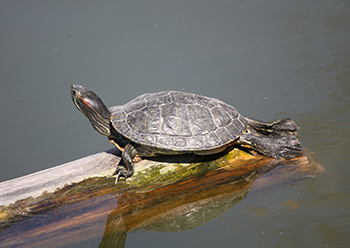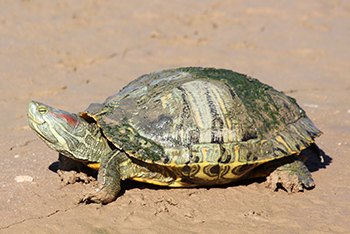Home → Fish & Wildlife → Wildlife → Species Information → Reptiles & Amphibians → Pond Slider
Pond Slider
Trachemys scripta
On this page:

Photo: Trevor Persons
Distinguishing Characteristics

Photo: Trevor Persons
- Medium-sized to large, carapace (upper part of shell) approximately 5 to 8 inches in length
- Carapace and body are green to brown with yellow or brown stripes
- Plastron (bottom part of shell) is yellowish with large black blotches
- Red-eared sliders (Trachemys scripta elegans) have a red stripe behind the eye, while yellow-bellied sliders (Trachemys scripta scripta) have a yellow blotch behind the eye
Status and Distribution in Maine
- Uncommon
- Exotic (non-native)
- Southern and central regions
Habitat
- Quiet, fresh deep water of ponds and lakes
- Areas with basking perches such as logs, rocks, vegetation, or exposed banks
Diet
- Omnivorous, eats wide variety of plants, invertebrates, and vertebrates including fish, frogs, and snakes
Seasonal Changes
- Occupies permanent water habitats year-round, probably hibernates in mud at bottom of ponds
Natural History Notes
- Most common pet turtle; unwanted captives often released into wild
- Only recently established in Maine, still few populations
- Often associates with painted turtles
Share Your Sighting
There is much still to learn about the distribution and ecology of Maine’s herpetofauna, and we encourage members of the public to share their photo-documented observations as part of the Maine Amphibian & Reptile Atlas Project (MARAP).
There are two ways to share your observations:
Submit your reptile or amphibian observation online
No service? No problem. Click here to download the survey to your device while connected, then take offline to collect observations from anywhere. Tip: The survey works best on Google Chrome and Safari.
Or upload sightings to the iNaturalist citizen science project through their website at iNaturalist.org or mobile app.
- When submitting an observation through iNaturalist add a description of the location (and other noteworthy information) to the “notes” field. This serves as a check on the locations automatically generated by smartphone cameras, which may be imprecise if cell service or GPS coverage is weak.
Thank you for doing your part to help conserve Maine’s reptiles and amphibians.